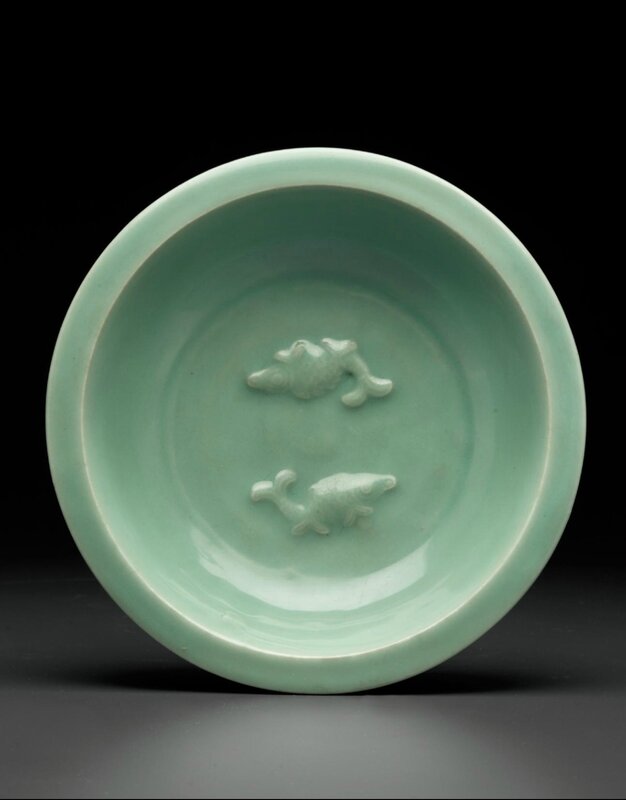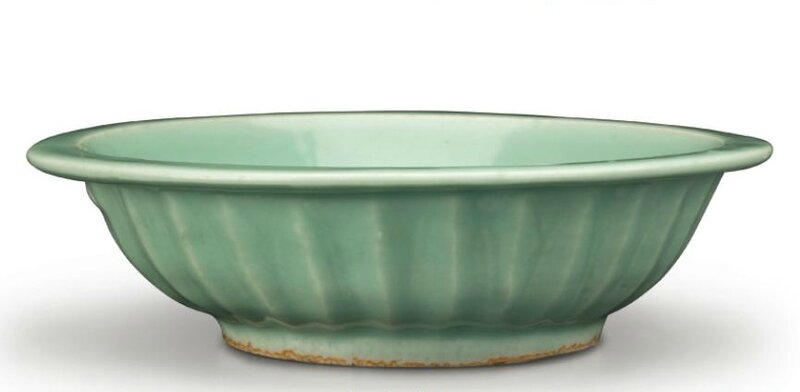A Longquan celadon 'Twin fish' dish, Late Southern Song-Yuan dynasty, 13th-14th century
A Longquan celadon 'Twin fish' dish, Late Southern Song-Yuan dynasty, 13th-14th century. Estimate 50,000 – $80,000 USD. Photo Christie's Image Ltd 2015
The rounded sides that rise from the tapering foot to the everted rim are carved on the exterior with a band of upright petals, and the center of the interior is relief-decorated with two small fish, all under a glaze of sea-green color that also covers the interior of the foot. 8 ¾ in. (22.2 cm.) diam.
Provenance: John Sparks Ltd., London, November 1950.
Collection of Lord Cunliffe. The Rt. Hon. Rolf, 2nd Baron Cunliffe of Headley (1899-1963).
The Cunliffe Collection; Bonham's London, 11 November 2002, lot 61.
Notes: The decorative scheme on this handsome dish claims a variety of meanings. At its most basic, it can be read simply as two fish swimming in the bluish-green waters of the small pond suggested by the dish’s circular form and aquatic color. But Chinese are fond of plays on words, particularly of puns based on homonyms, or words that are pronounced identically but have different meanings. Many Chinese designs thus lend themselves to presentation as rebuses, or visual puns. Pronounced yú in Mandarin Chinese, the word for “fish” is a homonym for “surplus” and, by extension, “abundance”. Thus, as a visual pun, the fish can be interpreted as a wish to the viewer for abundance in all things. Moreover, because there are two fish, Chinese viewers would interpret the design as shuangyú, which means “double fish” and, by extension, is an auspicious wish to the viewer for double abundance or great good fortune. Additionally, the double-fish motif stands as a symbol of marital harmony. See, Stacey Pierson, Designs as Signs: Decoration and Chinese Ceramics, London: Percival David Foundation of Chinese Art, School of Oriental and African Studies, University of London, 2001, p. 19.
The popularity of fish in Chinese art stems from a well-known passage in chapter 17 of the Daoist text Zhuangzi which recounts that when the philosopher Zhuangzi (c. 4th century BC) and his friend Huizi were strolling on a bridge above the Hao River, Zhuangzi exclaimed over the “happiness of the fishes”. Huizi questioned how Zhuangzi could know that the fish were happy. The argument that follows is resolved by Zhuangzi's final retort, “Let’s go back to the beginning: you asked whence I knew of the fishes’ happiness, thus already knowing that I knew. I know it just by being here above the Hao.” (Wendy Swartz, Robert Ford Campany, Yang Lu, and Jessey J.C. Choo, eds., Early Medieval China: A Sourcebook, New York, 2014, p. 242, note 13.) This favorable mention in a revered classical text assured fish of a place in the repertoire of Chinese art motifs.
It likely was a silver vessel from the Tang dynasty that inspired this and similar Longquan celadon dishes. Although used for inlays and for the occasional vessel or article of personal adornment since ancient times, silver and gold gained widespread popularity in China only in the Tang dynasty, beginning in the seventh century. Vessels in those precious metals influenced the shapes of Xing ware, the most famous of the early porcelains, and also of Tang-dynasty sancai,or 'three-color', ware. Obviously imitating the shape of a Tang silver dish, the famous sancai footed dish in the Mr. and Mrs. John D. Rockefeller 3rd Collection at The Asia Society, New York (1979.128), has the same broad flat floor, rounded cavetto, wide everted lip with thickened edge, and angular transition from cavetto to lip as the well-known Tang silver dish in the San Diego Museum of Art. Such broad-rimmed silver dishes most probably count among the ancestors of the present celadon dish.
A virtually identical dish with twin-fish motif from the Sakamoto Goro Collection sold at Sotheby’s New York, 16 September 2014, lot 2. The related but slightly smaller dish in the Metropolitan Museum (Oriental Ceramics: The World’s Great Collections, vol. 11: Metropolitan Museum of Art, Tokyo, 1982, pl. 51, no. 34.113.8) lacks the rising-lotus-petal décor that enlivens the exteriors of the present dish and that from the Sakamoto Collection. An example from the Riesco collection sold twice at Sotheby’s, London, once in 1984 and again in 1986, and then at Christie’s New York, on 19 September 2007, lot 260. Another Song example is published in Longquan Qingci (Longquan Celadon), Beijing, 1966, pl. 32. Yet another, from the Sir Percival David Collection and now in the British Museum, London, is illustrated in S. Pierson, Designs as Signs: Decoration and Chinese Ceramics, London, 2001, pl. 11.
Robert D. Mowry,
Alan J. Dworsky Curator of Chinese Art Emeritus, Harvard Art Museums, and Senior Consultant, Christie’s
Christie's. FINE CHINESE CERAMICS AND WORKS OF ART, 17 - 18 September 2015, New York, Rockefeller Plaza

/https%3A%2F%2Fprofilepics.canalblog.com%2Fprofilepics%2F1%2F0%2F100183.jpg)
/https%3A%2F%2Fstorage.canalblog.com%2F03%2F02%2F119589%2F96711876_o.jpg)
/https%3A%2F%2Fstorage.canalblog.com%2F11%2F31%2F119589%2F94773502_o.jpg)
/https%3A%2F%2Fstorage.canalblog.com%2F20%2F83%2F119589%2F94772815_o.jpg)
/https%3A%2F%2Fstorage.canalblog.com%2F26%2F72%2F119589%2F75604929_o.jpg)
/https%3A%2F%2Fstorage.canalblog.com%2F59%2F60%2F119589%2F26458628_o.jpg)




/image%2F1371349%2F20240412%2Fob_a95ef1_2024-nyr-22642-0932-000-a-longquan-cel.jpg)
/image%2F1371349%2F20240412%2Fob_e4dd96_2024-nyr-22642-0930-000-a-longquan-cel.jpg)
/image%2F1371349%2F20240411%2Fob_4a5248_2024-nyr-22642-0913-000-a-longquan-cel.jpg)
/image%2F1371349%2F20240406%2Fob_f762e5_435810099-1646427029460643-74606500582.jpg)